Everyday Paleo (58 page)
Authors: Sarah Fragoso
Tags: #Diets, #Healthy Living, #Health & Fitness, #General


Slowly lower yourself back down to the floor, holding tight to baby. Do not crash back down—this should be a controlled decent.
Baby Bridge with Press
This movement has the same benefits as the baby bridge, but due to the added press, you also build strength in the chest and shoulders. As a side note, be sure to make airplane noises for your little one and enjoy the giggles!
MUSCLES USED: Gluteals, Hamstrings, Erector Spinae, Abdominals, Pectoralis, Deltoids, and Triceps

Start in the same position as the baby bridge, but this time hold your child under his arms and around his chest.
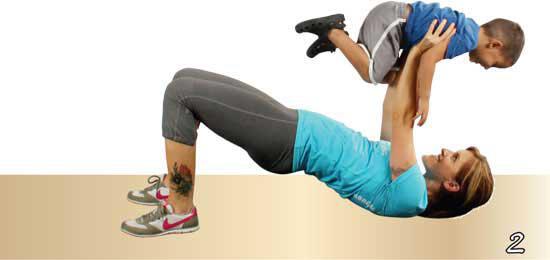
As you raise your hips into the bridge position, press your child directly above your chest. Your hands should be lined up with your shoulders in the finished positioned, arms fully extended. With your baby held up, maintain the bridge position for 10–30 seconds.

Slowly lower your hips back to the ground and your baby back to your chest. Once accomplished, repeat the movement.
Baby Squat
Again, toddlers and babies make excellent weights and offer a wonderful excuse to exercise! This movement is the same as the traditional squat, but with a little added resistance. If your baby is small enough to still fit in a baby wrap or front carrier, you can also wear your little one while you perform this movement. However, do not try this movement unless you are strong enough to squat to full depth on your own!
MUSCLES USED: Quadriceps, Gluteals, and Hamstrings

1)
Hold your child in front of you, wrapping your arms around him or her tightly. If you have a toddler, instruct him to wrap his legs around your middle. Stand with your feet shoulder width apart.
2)
Keeping your weight in your heels, begin to reach your hips back and down. Make sure to keep your weight in your heels, hold your baby tight, and keep your chest upright.
3)
Continue to lower yourself down until you reach a full-depth squat position.
4)
Push up through your heels and begin to return to the standing position.
5)
Once you return to a full upright position, you are ready to repeat the movement. Remember to keep your tummy and leg muscles tight, and when you begin to feel fatigued, put baby down and rest or finish your reps without holding your little one.

Baby Lunge
What is great about performing baby lunges with your little one is that you do not need a whole lot of room. While walking lunges demand a great amount of space, baby lunges can be performed indoors. All you have to do is clear a space in your living room or bedroom! Again, no excuses not to get moving! This movement works the glutes and inner-thigh muscles while also helping to strengthen your core.
MUSCLES USED: Gluteals, Hamstrings, Quadriceps, and Adductors

1)
Hold baby as instructed in the previous baby squat sequence and position your feet directly under your shoulders. You can also wear baby in a wrap or front carrier for this movement.
2)
Looking straight ahead and holding baby tightly to your chest, take a giant step forward with your right foot. Since you are beginning with your right leg, you want to step slightly toward one o’clock. This will help you to maintain balance.
3)
Drop your left knee toward the ground, making sure to keep your chest upright and your tummy tight. The shin of your front leg should stay vertical with your knee and track over your heel, not your toes. Continue to sink your left knee down until it is just above the ground.
4)
Pushing up through the heel of your front leg, begin your return to a vertical position. You should feel this movement in your fanny as you rise.
5)
As you return to the start position, make sure that your shoulders and tummy are tight. Once accomplished, repeat the movement exactly as described, but this time step forward with your left leg. Continue to lunge, alternating legs as you go.

Partner Movements
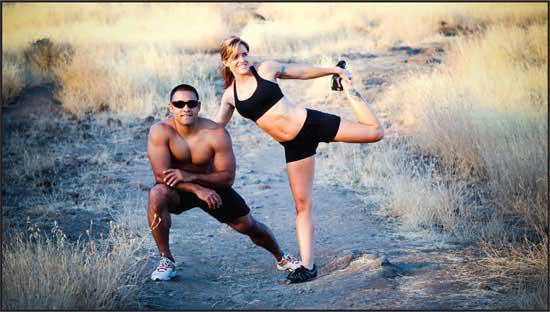
L
ast but not least, we will look at some fun movements that you can try with your significant other or with a friend. Working out together as a couple is a great way to reconnect after a long day and can truly enhance a relationship as you both work toward the goal of optimal health. A few of the following movements might be a bit more advanced, but I will offer either modifications or other options. The main point of this section is to focus on having fun with your partner while working out. Make sure to be encouraging and supportive of one another. Part of exercising together should be about building one another up instead of focusing on one another’s weaknesses. Working together toward a common goal can strengthen relationships, open lines of communication, build trust, and lend insight to different things about one another that you might not have noticed before. One of my first dates with John was at a gym. Yes, we were that couple, flirting with each other on the treadmill, making you want to scream because obviously we were not getting a whole lot of working out actually accomplished. Fast-forward twelve years later and we still enjoy working out together, although our lives are completely different and so are our health and fitness goals. John likes the competitive side of being athletic, and I simply enjoy being strong, ft, and healthy enough to keep up with my boys. With that being said, we have found a wonderful balance. John pushes me to work harder in the gym, but always with love and respect because he knows when I am just being lazy and can step it up a bit. I keep John focused and remind him that overtraining is just as bad as not training enough, and I never let him get away with anything other than solid technique. Together, we make a pretty good team, and we have learned how to be good partners in and outside of the gym.
Wheelbarrow
The wheelbarrow is about the fun and balance that a couple should have when exercising together. Balance refers to understanding when to encourage your partner and when just to be there. And the fun aspect refers to never taking yourself or each other too seriously.
MUSCLES USED: All of them, a great full body exercise

Start in the push-up position, and then have your partner grab your ankles and lift your lower body off the floor. It is very important to make sure that your tummy and back are tight, as well as your glutes and legs.
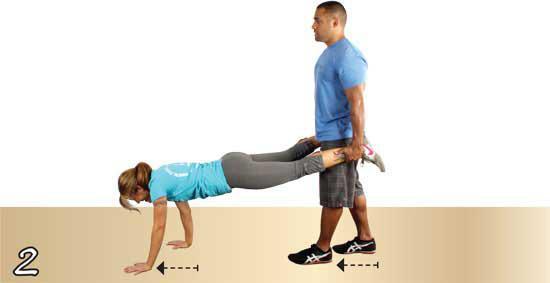
As you step your left hand forward, your partner steps his left foot forward.

As you step your right hand forward, your partner steps his right foot forward.
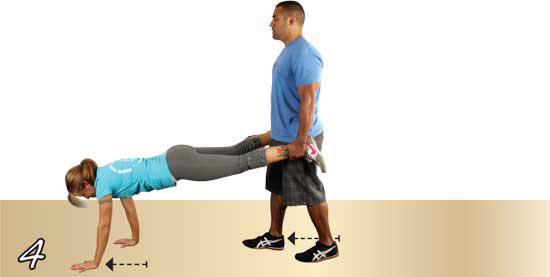
Going at your own pace, walk your hands forward as your partner walks behind you supporting your legs. It is important for your partner to match your pace rather than the other way around. Walk this way for a predetermined distance (start out going just a few feet to see how you feel.) Make sure your partner lets you down gently; trade places and repeat!
Partner Push-up
The partner push-up provides great exercise for both parties involved! The person on bottom works his or her core while the person on top works his or her chest and shoulders. The optimal goal is to switch positions at some point in your workout, but if there is a great weight difference between you and your partner, I recommend starting out with the heavier partner holding the plank position on the ground and the lighter partner perform the push-ups in the top position. Once the lighter partner develops the strength needed to safely hold the weight of the other, you can begin switching positions.
MUSCLES USED: Plank Position—Erector Spinae, Abdominals, Quadriceps, and Gluteals. Push-Ups—Pectoralis, Deltoids, and Triceps
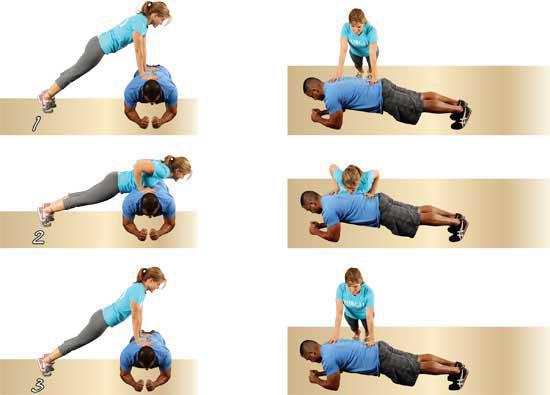
1)
Have the heavier/stronger partner hold the plank position. The lighter partner should position herself with one palm on the upper back and one palm on the lower back of the partner holding the plank. If you are on top, walk your feet out until your spine and legs are one straight line. Make sure to look down in front of you and keep your neck in a neutral position.
2)
Perform a push-up, lowering your chest all the way to your partner’s back.
3)
Push all the way back up until your arms are fully extended. See how many push-ups your can perform in 10- to 30-second time increments or until your plank partner needs a break. Rest for a minute, and then switch positions. Just make sure you can safely hold the weight of your partner in the plank position.
Partner Sit-Up
Although this movement does not add to the difficultly level of the push-ups described earlier in the book, it adds an element of fun. Personally, I like to match my partner’s pace so that we can high-five every time we perform a sit-up. If you hadn’t guessed it, this is a great movement to have the kids be involved in as well.
MUSCLES USED: Abdominals, Gluteals, Hamstrings

To begin this movement, both you and your partner should lie flat on the floor with your knees bent and your feet interlocked. Your feet should be about two feet away from your fanny, and your arms should be lying flat on the ground above you.

At the same time, both you and your partner should swing your arms forward to generate the momentum needed to sit up. When done correctly, both of you should elevate your chest toward your knees at the same pace.

